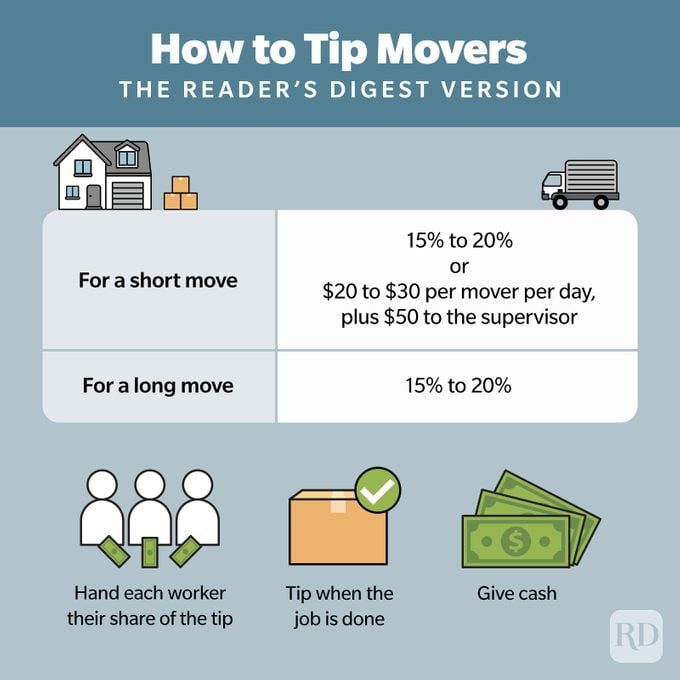This Is How Much to Tip Your Movers
Updated: Feb. 01, 2024

Packing up your life and heading to a new location? Here's how, when and how much to tip movers.
Moving from one place to another sounds like it should be simple, but if you’ve ever moved, you know how quickly things get complicated. It’s so stressful, in fact, that when OnePoll asked 1,000 Americans about their moving experience, 64% said it was one of the most stressful things they’ve ever done. That’s because moving your stuff from one place to another isn’t the only stressor. All the little details—like how much to tip movers—can make the process of moving so incredibly draining.
“How much to tip often feels like a gray area with constantly changing rules, and it can feel frustrating when you don’t know what to expect,” says Valerie Sokolosky, an etiquette and tipping expert and author of Do It Right. We asked her to share everything you need to know about how much to tip movers. That way, you can focus your energy on all the big things that need your attention, like boxing up your best dishware without chipping a single plate.
When you’re done, brush up on tipping etiquette for other areas of your life, including how much to tip a hairdresser, how much to tip at a nail salon and how to tip around the world.
Get Reader’s Digest’s Read Up newsletter for more etiquette, humor, cleaning, travel, tech and fun facts all week long.
Do you need to tip your movers?
Yes, you should always tip movers, even if your company is paying for the move, says Sokolosky. “Like a lot of etiquette rules, it comes down to empathy and putting yourself in the other person’s shoes,” she says. “Many movers will say they don’t require or even expect tips, but moving is a tough, physically demanding job, and a good tip is a way of showing gratitude.”
Movers are paid an hourly wage, so tips aren’t factored into their salary. But what you may not realize is that the moving fee you pay primarily covers the company’s overhead—think truck maintenance and logistical costs. The workers doing all the heavy lifting don’t get much. The average pay for a mover in the United States is $18 an hour, or about $40,000 per year. But it ranges from $16,000 to $65,000 a year depending on the area of the country. (For reference, the poverty line according to the U.S. government is just under $36,000.)
“A generous tip helps movers make a living wage,” Sokolosky says, adding that these people are handling all your worldly belongings, so this isn’t the time to be cheap.

How much to tip movers
No matter how quick and seemingly easy your move is, not tipping at all is a major etiquette mistake. Instead, aim to pay a 15% tip for adequate service or 20% for good service.
Keep in mind: This varies depending on the type of move, says Sokolosky. Moving from one small apartment to another across town is a very different endeavor than packing up a large household and going across the country, and your tip should reflect the amount of work the movers are doing.
How much to tip for short moves
The average cost for a short move is $800 to $2,150, so a 20% tip would range from $160 to $430, split between all the workers. The 20% rule is solid advice, but there’s another way you can calculate a tip for short moves: Simply tip a round number in cash, normally $20 to $30 per mover per day and $50 to the supervisor.
How much to tip for long-distance moves
Longer moves average $2,200 to $5,700 and require more work packing, transporting, unloading and temporarily storing your stuff. Because of the work involved, you should budget for a 20% percent tip as part of your moving costs, especially if the same crew is moving you out of your old home and into your new place, Sokolosky says.
This means tipping $440 to $1,140 for a move that takes longer than one day and/or is farther than 200 miles.
If it’s the same moving crew the entire trip, pay the tip at the completion of the move. If you’re dealing with a different team of movers at each end, calculate the total tip and give half to the movers at your current location and the other half to the movers at your destination.
How to tip movers
Whether you’re tipping hotel housekeeping, dog groomers, massage therapists or movers, cash is always the preferred method. In fact, it may be the only option offered by smaller moving companies. “Giving cash ensures that your tip goes to the people doing the work on the ground,” says Sokolosky. The crew may accept a personal check, but always ask first.
Tip at the completion of the job. For short moves, you can tip once everything is unloaded at the destination. For long moves, tip half of it after the loading is finished at your current place and the other half after the unloading is finished at your new place. (But, as noted above, if the same team is handling your entire long-distance move, you can tip after everything is unloaded at your new place.)
So, who exactly are you tipping? You can hand the cash to the moving supervisor and ask him or her to divide it equally among the crew, but Sokolosky prefers to hand it to each worker individually. “This allows me to make sure each person gets their tip but even more important gives me the opportunity to thank each person individually for their help,” she says.
You may want to consider other ways to tip and show gratitude to your movers, she adds. Buying the crew lunch, offering cold drinks and setting out snacks are always nice gestures.
What to consider when tipping movers
Just as there are tons of packing tips to make boxing up your house a breeze, there are a lot of variables that help determine how much to tip movers, says Sokolosky. Focusing on the six below will help you gauge the best gratuity for your move.
Quality of service
According to Sokolosky, the most important consideration is whether the movers did a good job. “Keep in mind that moving costs have gone up exponentially in the past few years due to inflation, so consider a 20% tip for companies that provide great service,” she says.
Extra effort
Moving a waterbed? How about a sleeper sofa? When you have tricky-to-transport items, tack on a little extra to your tip. (Of course, there are certain items that don’t belong on a moving truck—we’re looking at you, baby grand piano—so do your research beforehand.)
Bump up the tip for any job where the workers go above and beyond normal duties. If you have an extra car that must be towed or need the movers to disassemble furniture, compensate them for the work.
The size of your house
Your home’s size plays a role in how much to tip movers. But here’s some good news: You don’t have to do any extra math to account for it. The number and type of rooms in your house, plus the amount of packing the movers need to do, will all be calculated in the quote from the moving company, so base your tip off the final quote, Sokolosky says.
How far you’re moving
Long-distance moves require far more manpower, resources, gas, time and insurance, so expect to tip more for moves that take more than one day, leave your metropolitan area and/or are more than 200 miles. For shorter moves, you may be able to offer cold drinks and a $20 bill to each mover, but for longer moves, plan on 20% handed to the workers in cash.
Number of movers and moving time
Moving companies will calculate the number of people needed to accomplish the job in the timeframe required, so you don’t need to do any extra math to target the number of movers and amount of time it takes to get your belongings to your new place. Take the appropriate percentage of the final bill and divide the total tip by the number of movers to know how much to give each person. If you’re unsure, give the total amount to the supervisor and ask them to split it among the crew.
The contract
It’s rare, but occasionally moving companies will include the tip in the final cost estimate, so be sure to ask what the company’s policy is and look through your moving contract closely for any extra fees. If the tip is included, then you do not need to tip extra.
Sources:
- Valerie Sokolosky, etiquette and tipping expert and author of Do It Right
- OnePoll: “Is moving really this stressful?”
- Forbes: “How much do movers cost?”
- Indeed: “Mover salary in United States”


























